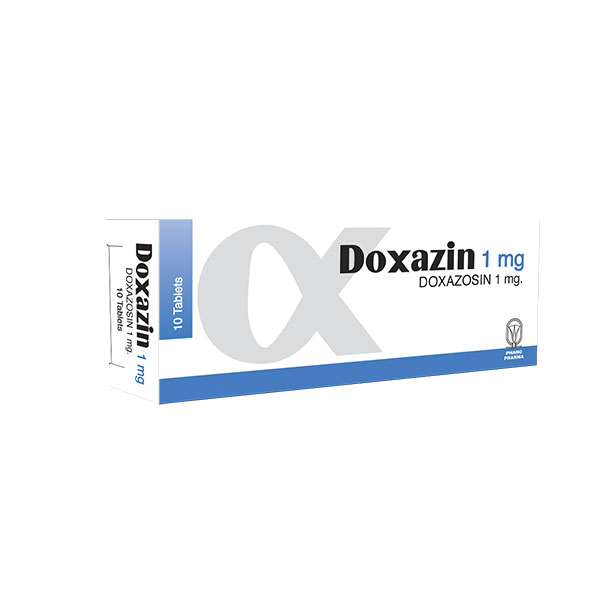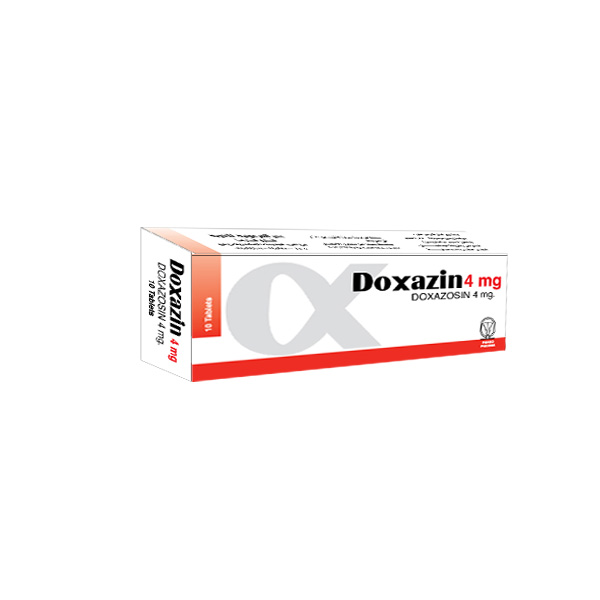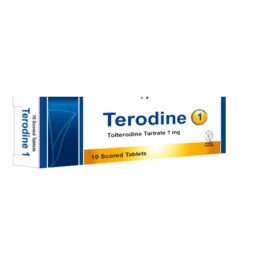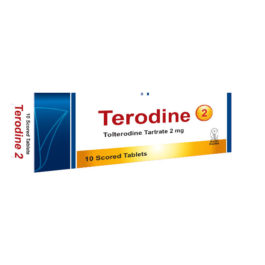Description
PHARMACEUTICAL FORM
Tablets
Clinical particulars
THERAPEUTIC INDICATIONS:
• Essential hypertension. Doxazosin is not appropriate for first-line treatment. It may be used as a monotherapy in patients who have failed to respond to or have contraindications to other agents. Alternatively, use should be limited to second or third line treatment in combination with other antihypertensives.
- Symptomatic treatment of benign prostatic hyperplasia.
POSOLOGY AND METHOD OF ADMINISTRATION
Doxazosin may be administered either in the morning or in the evening.
-Hypertension:
The full dosage range of Doxazin is 1-16 mg daily It is recommended that therapy be initiated at 1 mg given once daily for one or two weeks The dosage may then be increased to 2 mg once daily for an additional one or two weeks, If necessary, the daily dosage should then be increased gradually at similar intervals to 4 mg, 8mg, and 16 mg as determined by patient response to achieve the desired reduction in blood pressure
The usual dose is 2-4 mg once daily.
-Benign Prostatic Hyperplasia:
The initial dosage of Doxazin is 1 mg g;ven once daily Depending on the individual patients urodynamics and BPH symptomatology,dosage may then be increased to 2 mg and, thereafter, to 4 mg and up to the maximum recommended dose of 8 mg The recommended titration interval is 1-2 weeks The usual recommended dose is 2-4 mg once daily
-Use in Renally impaired:
Since the pharmacokinetics of Doxazin are unchanged in patients with renal insufficiency, and there is no evidence that Doxazin aggravates existing renal dysfunction the usual dosages may be used in these patients
-Use in Children:
No experience is available on usage of Doxazin in children .
CONTRAINDICATIONS:
Doxazin is contraindicated in patients with a known hypersensitivity to quinazolines.
SPECIAL WARNINGS AND PRECAUTIONS FOR USE
Postural Hypotension/Syncope:
Initiation of Therapy – As with all alpha-blockers, a very small percentage of patients have experienced postural hypotension evidenced by dizziness and weakness, or rarely loss of consciousness (syncope), particularly with the commencement of therapy.
Therefore, it is prudent medical practice to monitor blood pressure on initiation of therapy to minimise the potential for postural effects.
When instituting therapy with any effective alpha-blocker, the patient should be advised how to avoid symptoms resulting from postural hypotension and what measures to take should they develop. The patient should be cautioned to avoid situations where injury could result, should dizziness or weakness occur during the initiation of Doxazin therapy.
Use in patients with Acute Cardiac Conditions:
As with any other vasodilatory anti-hypertensive agent it is prudent medical practice to advise caution when administering doxazosin to patients with the following acute cardiac conditions:
– pulmonary oedema due to aortic or mitral stenosis
– high-output cardiac failure
– right-sided heart failure due to pulmonary embolism or pericardial effusion
– left ventricular heart failure with low filling pressure.
Use in Hepatically Impaired patients:
As with any drug wholly metabolised by the liver, Doxazin should be administered with particular caution to patients with evidence of impaired hepatic function.Since there is no clinical experience in patients with severe hepatic impairment use in these patients is not recommended.
Use with PDE-5 Inhibitors:
Concomitant administration of doxazosin with phosphodiesterase-5-inhibitors (eg sildenafil, tadalafil, and vardenafil) should be done with caution as both drugs have vasodilating effects and may lead to symptomatic hypotension in some patients. To reduce the risk of orthostatic hypotension it is recommended to initiate the treatment with phosphodiesterase-5-inhibitors only if the patient is hemodynamically stabilized on alpha-blocker therapy. Furthermore, it is recommended to initiate phosphodiesterase-5-inhibitor treatment with the lowest possible dose and to respect a 6-hour time interval from intake of doxazosin. No studies have been conducted with doxazosin prolonged release formulations.
Use in patients undergoing cataract surgery:
The ‘Intraoperative Floppy Iris Syndrome’ (IFIS, a variant of small pupil syndrome) has been observed during cataract surgery in some patients on or previously treated with tamsulosin. Isolated reports have also been received with other alpha-1 blockers and the possibility of a class effect cannot be excluded. As IFIS may lead to increased procedural complications during the cataract operation current or past use of alpha-1 blockers should be made known to the ophthalmic surgeon in advance of surgery.
Patients with rare hereditary problems of galactose intolerance, the Lapp lactase deficiency or glucose-galactose malabsorption should not take this medicine.
INTERACTION WITH OTHER MEDICAMENTS AND OTHER FORMS OF INTERACTION:
-Most(98%)of plasma Doxazin is protein- bound In vitro data in human plasma indicate that Doxazin has no effect on protein binding of digoxin warfarin phenytoin or indomethacin.
-Doxazin has been administered without any adverse drug interaction in clinical experience with thiazide diuretics, frusemide, beta-blockers, non-steroidal anti-inflammatory drugs, antibiotics, oral hypoglycemic drugs, uricosuric agents. or anticoagulants.
PREGNANCY AND LACTATION:
-Although no teratogenic effects were seen in animal testing, reduced fetal survival was observed in animals at extremely high doses These doses were approximately 500 times the maximum human recommended dose As there are no adequate and well controlled studies in pregnant or nursing women, the safety of Doxazin use during pregnancy or lactation has (lot yet been established Accordingly during pregnancy or lactation doxazosin should be used only when in the opinion of the physician, potential benefit outweighs risk.
EFFECTS ON ABILITY TO DRIVE AND USE MACHINES:
The ability to engage in activities such as operating machinery or operating a motor vehicle may be impaired especially when initiating therapy.
UNDESIRABLE EFFECTS:
| MedDRA System Organ Class | Frequency | Undesirable Effects |
| Infections and infestations | Common | Respiratory tract infection, urinary tract infection |
| Blood and lymphatic system disorders | Very Rare | Leukopenia, thrombocytopenia |
| Immune System Disorders | Uncommon | Allergic drug reaction |
| Metabolism and Nutrition Disorders | Common | Anorexia |
| Uncommon | gout, increased appetite | |
| Psychiatric Disorders | Common | Anxiety, insomnia, nervousness |
| Uncommon | Agitation, depression | |
| Nervous System Disorders | Very common | Dizziness, headache |
| Common | Dizziness postural, paresthesia, somnolence | |
| Uncommon | Cerebrovascular accident, hypoesthesia, syncope, tremor | |
| Eye Disorders | Very Rare | Blurred vision |
| Unknown | Introperative floppy iris syndrome | |
| Ear and Labyrinth Disorders | Common | Vertigo |
| Uncommon | Tinnitus | |
| Cardiac Disorders | Common | Palpitation, tachycardia |
| Uncommon | Angina pectoris, myocardial infarction, cardiac arrhythmias | |
| Very Rare | Bradycardia | |
| Vascular Disorders | Common | Hypotension, postural hypotension |
| Uncommon | Hot flushes | |
| Respiratory, Thoracic and Mediastinal Disorders | Common | Bronchitis, cough, dyspnea, rhinitis |
| Uncommon | Epistaxis, cough | |
| Very Rare | Bronchospasm aggravated | |
| Gastrointestinal Disorders | Common | Abdominal pain, dyspepsia, dry mouth, nausea, diarrhoea |
| Uncommon | Constipation, flatulence, vomiting, gastroenteritis | |
| Unknown | Taste disturbances | |
| Hepatobiliary Disorders | Uncommon | Abnormal liver function tests |
| Very Rare | Cholestasis, hepatitis, jaundice, abnormal liver function tests | |
| Skin and Subcutaneous Tissue Disorders | Common | Pruritus |
| Uncommon | Skin rash, alopecia, purpura | |
| Very Rare | urticaria | |
| Musculoskeletal and Connective Tissue Disorders | Common | Back pain, myalgia |
| Uncommon | Arthralgia, muscle cramps, muscle weakness | |
| Renal and Urinary Disorders | Common | Cystitis, urinary incontinence |
| Uncommon | Dysuria, micturition frequency, hematuria, polyuria, urinary incontinence | |
| Very Rare | Increased diuresis, micturition disorder, nocturia | |
| Reproductive System and Breast Disorders | Uncommon | Impotence |
| Very Rare | Gynecomastia, priapism | |
| Unknown | Retrograde ejaculation | |
| General Disorders and Administration Site Conditions | Common | Asthenia, chest pain, influenza-like symptoms, peripheral oedema, fatigue, malaise |
| Uncommon | Pain, facial oedema | |
| Investigations | Uncommon | Weight increase |
OVERDOSE:
Should overdosage lead to hypotension, the patient should be immediately placed in a supine, head down position. Other supportive measures should be performed if thought appropriate in individual cases
Since Doxazin is highly protein-bound, dialysis is not indicated.
Pharmacological properties
PHARMCODYNAMIC PROPERTIES:
-Doxazin exerts its vasodilator effect via selective and competitive blockade of post-junctional
alpha-1-adrenoceptors.
-Administration of Doxazin to hypertensive patients causes a clinically significant reduction in blood pressure as a result of a reduction in systemic vascular resistance This effect is thought to result from selective blockade of the alpha-1-adrenoceptors located in the vasculature. With once-daily dosing, clinically significant reductions in blood pressure are present throughout the day and at 24 hours post- dose.
-A gradual reduction in blood pressure occurs with maximum reductions usually occurring 2-6 hours after dosing In patients with hypertension, blood pressures during treatment with
Doxazin were similar in both the supine and standing positions Unlike non-selective alpha adrenoceptor blocking agents, tolerance has not been observed in long term therapy with Doxazin. -Elevations of plasma renin activity and tachycardia were seen infrequently in sustained therapy Doxazin produces favorable effects on blood lipids with a significant increase in the HDL/total cholesterol ratio and significant reductions in total triglycerides and total cholesterol It, therefore confers an advantage over diuretics and beta-adrenoceptor blocking agents which adversely affect these parameters based on the established association of hypertension and blood lipids with coronary heart disease, the favourable effects of doxazosin therapy on both blood pressure and lipids indicate a reduction in risk of developing coronary heart disease
-Treatment with Doxazin has been shown to result in regression of left ventricular hypertrophy, inhibition of platelet aggregation and enhanced tissue plasminogen activator capacity. Additionally, Doxazin improves insulin sensitivity in patients who have impairment.
-In a controlled clinical trial in hypertensive patients, treatment with doxazosin was associated with improvement of erectile dysfunction. In addition the patients who received doxazosin reported fewer new cases of erectile dysfunction than those who received other antihypertensive agents
-Administration of Doxazin to patients with symptomatic BPH results in a significant improvement in urodynamics and symptoms. The effect in BPH is thought to result from selective blockade of the alpha-1-adrenoceptors located in the prostatic muscular stroma, capsule and bladder neck
Doxazin has been shown to be an effective blocker of the 1A subtype of the alpha1-adrenoceptors which accounts for over 70% of the subtypes in the prostate This accounts for the action in BPH patients.
-Doxazin has demonstrated sustained efficacy and safety in the long-term treatment of BPH (i e. up to 48 months) Doxazin has been shown to be free of adverse metabolic effects and is suitable for use in patients with asthma diabetes, left ventricular dysfunction, gout and in elderly patients.
An in vitro study has demonstrated the antioxidant properties of the 6- and 7-hydroxy metabolites of doxazosin at concentrations of 5 micromolar.
PHARMACOKINETIC PROPERTIES
Absorption:
After oral administration of therapeutic doses, Doxazin is well absorbed with peak blood levels occurring at about 2 hours.
Biotransformation/Elimination:
The plasma elimination is biphasic with the terminal elimination half-life being 22 hours and hence this provides the basis for once-daily dosing Doxazosin is extensively metabolized with <5% excreted as unchanged drug
Pharmacokinetic studies in the elderly and patients with renal insufficiency have shown no significant alterations compared to younger patients with normal renal function There are only limited data in patients with liver impairment and on the effects of drugs known to influence hepatic metabolism (e g. cimetidine) As with any drug wholly metabolized by the liver, use of doxazosin in patients with altered liver function should be undertaken with caution (Special Warnings and Special Precautions for Use)
PACKING: A carton box containing 10 tablets in 1 PVC/Al strip and a pamphlet.
STORAGE:
Keep at a temperature not exceeding 30°C, in dry place.
Keep out of reach of children.










Reviews
There are no reviews yet.